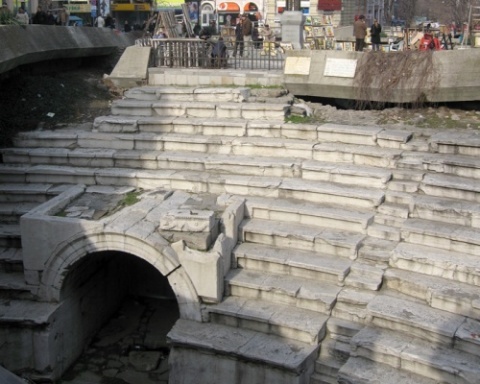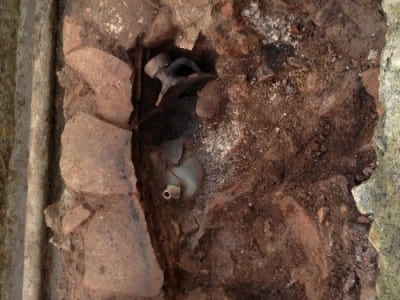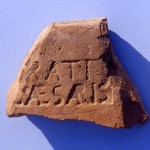The Roman Archaeology Blog is concerned with news reports featuring Roman period archaeology. If you wish to see news reports for general European archaeology, please go to The Archaeology of Europe Weblog.
Thursday, November 29, 2012
Digs reveal evolution of Paphos theatre
Fragments of marble sculptures from a monument consecrated to the nymphs of ancient Greek and Roman mythology have been uncovered during on-going excavations at Paphos' ancient theatre, the archaeological team in charge of the dig have announced.
The 15th season of excavations into one of Cyprus’ largest ancient theatres unearthed a number of significant finds, including fragments of carved marble adornments from the stage and from a monument to the nymphs or nymphaeum.
Paphos was the capital of Cyprus in Greek and Roman times and its ancient archaeological remains are on the World Heritage List.
Read the rest of this article...
Bulgaria Unearths Ancient 'Millionaire's' Treasure
Bulgarian archaeologists have unearthed 40 silver coins during excavations in the second largest city of Plovdiv.
The coins, dating from the 3rd century A.C., have images of a number of Roman Emperors or different Gods.
They are extremely well-preserved, meaning they have not been in circulation, experts say.
The coins were located in an ancient hiding place and were a real treasure for this period with their owner being a very wealthy man, they further explain, adding the hiding place in the floor showed the said owner had intentions to get them back at some point, but was prevented, most likely because he was killed.
Read the rest of this article...
Tuesday, November 27, 2012
Winchester Palace Roman Wall Painting Website
Sadly, the erstwhile conservator for the Department of Greater London Archaeology, Sean A. MacKenna (Tony MacKenna), Tony died in October 2012.
The most important project of his career was the excavation and restoration of the Winchester Palace Roman wall painting. Tony had published a detailed account of the work on his own website, but that website will not remain.
The material has, therefore, been transferred to the Archaeology in Europe website. You can find it at:
www.archeurope.com/index.php?page=winchester-palace-roman-wall-paintings
The work is sure to be of considerable interest to Romanists and Conservators alike.
Go to the website...
Weitere Spuren römischer Besiedlung in Liechtenstein
Im Oktober entdeckte das Team der Landesarchäologie im Winkel in Balzers weitere Spuren der römischen Siedlung. Dabei handelt es sich um die letzten Reste eines Gebäudes, das vermutlich von den unberechenbaren Fluten des Rheins zerstört worden ist.
Bei Aushubarbeiten kamen in einer Kiesschicht ca. 1,5 Meter unter der Oberfläche römische Funde ans Tageslicht. Das eingestürzte Mauerwerk mit Resten eines rötlichen Verputzes und die Dachziegelfragmente dürften von einem Gebäude stammen. Sie werden genau gleich wie die Keramikscherben in das 2./3. Jahrhundert n. Chr. datiert.
Read the rest of this article...
Thursday, November 22, 2012
Roman jug found behind Estepona high street
A ROMAN jug has been unearthed behind Estepona high street.
A team of archaeologists discovered the ancient artifact yesterday morning close to the town’s shopping area.
Sailing instructor Tomas Reyes spotted the organised dig outside his house and took the snap above.
“It was very interesting, it must be at least 2,000 years old.
“I asked if I could take a picture as they found it,” said Reyes.
Romans used the containers to transport liquids such as water, wine, oil and honey.
Read the rest of this article...
Excavating a Roman Floor
Not only have our archaeologists have been hard at work carefully excavating the heart of Roman Londinium, they’ve been given a chance to play with some new kit. And now we have a chance to take you out on site with us through the power of time-lapse video! In a series of videos we recorded the whole process of uncovering, recording and lifting a Roman tessellated floor! The first video follows our archaeologists (and our friendly McGee site labourers) uncovering the tessellated floor by removing the trampled material that lay on top.
So here is the first in our series of videos featuring our lovely archaeologists, a massive Roman tessellated floor, and some homegrown rock and roll for good measure:
Watch the video...
Wednesday, November 21, 2012
Ancient tunnels in Rome reopen to the public
The network of underground passageways beneath the Baths of Caracalla is also home to the largest temple of Mithra in the Roman Empire
Few people have ever visited the long network of
underground tunnels under the public baths of Caracalla, which date back
to the third century AD and are considered by many archaeologists to be
the grandest public baths in Rome. This underground network, which is
due to be reopened in December, is also home to a separate structure,
the largest Mithraeum in the Roman Empire, according to its director
Marina Piranomonte. The Mithraeum has just reopened after a year of
restoration work which cost the city’s archaeological authorities around
€360,000.
Read the rest of this article...
Monday, November 19, 2012
Water mains work unearths Roman cemetery in Somerset
Several Roman human remains were discovered at Banwell in Somerset
A Roman cemetery containing several human burials has been found during work on a new water mains in Somerset.
Among the skeletons, which have been exhumed for further study, there was one in a partially-preserved coffin.
A Bristol Water spokesman said the excavation had been described as "potentially the most important for 100 years in North Somerset".
The cemetery was discovered "isolated from the surrounding landscape" in a curved water-filled ditch.
Roman cemeteries, according to Neil Shurety from Border Archaeology, are generally sited outside settlements and away from areas of human habitation.
Read the rest of this article...
Sunday, November 18, 2012
Summer Courses in Archaeology
Oxford Experience Archaeology Courses
The Oxford Experience Summer
School offers weekly introductory courses in the Sciences and Humanities. Participants stay in Christ Church, the
largest and one of the most beautiful Oxford Colleges.
Pompeii collapses 'exaggerated' by media, site chief says
Paestum, November 16 - Recent collapses at the ancient city of Pompeii had been exaggerated by the media and efforts to protect the site are progressing, according to the Special Archaeological Superintendent for Naples and Pompeii, Teresa Elena Cinquantaquattro.
Cinquantaquattro was speaking along with other senior archaeological officials from the culture ministry at the 15th annual Mediterranean Archaeological Tourism Exchange in Paestum on how to conserve sites in southern Italy in a climate of shrinking government funds. "Problems exist at Pompeii but they have been exaggerated by negative journalists," Cinquantaquattro told ANSA.
After recent falls of structures in the past two years there has been growing concern about Italy's ability to protect the 2,000-year-old site from further degradation and the impact of the local mafia, the Camorra. In April this year a wall surrounding an ancient villa at Pompeii collapsed just two weeks after the Italian government launched a joint 105-million-euro project with the European Union to save the UNESCO World Heritage site.
Read the rest of this article...
Thursday, November 15, 2012
Escaping the Shadow of Pompeii
HERCULANEUM, Italy — They are poignant snapshots of sudden death: huddled clusters of skeletal remains in what were once beachfront warehouses, immortalized for eternity when Mount Vesuvius smothered this ancient Roman town in A.D. 79.
“They died of thermal shock as they were waiting to be saved via the
sea,” Domenico Camardo, an archaeologist, said recently as he surveyed
dozens of modern-day skeletal casts of long-ago denizens. They carried
with them jewelry, coins, even “20 keys, because they were hoping to
return home,” Mr. Camardo added. “They didn’t understand that it was all
about to end.”
First excavated by archaeologists some 30 years ago, the warehouses were
recently outfitted with walkways and gates to provide access to these
chilling tableaus and will soon be open to the public on special
occasions.
Read the rest of this article...
Saving the ruins of Herculaneum
HERCULANEUM, Italy
They are poignant snapshots of sudden death: Huddled clusters of
skeletal remains in what were once beachfront warehouses, preserved when
Mount Vesuvius smothered this ancient Roman town in A.D. 79.
”They died of thermal shock as they were waiting to be saved via the
sea,” Domenico Camardo, an archaeologist, said recently as he surveyed
dozens of modern-day skeletal casts of long-ago denizens.
They carried with them jewellery, coins, even “20 keys, because they were hoping to return home,” Camardo added. “They didn’t understand that it was all about to end.”
They carried with them jewellery, coins, even “20 keys, because they were hoping to return home,” Camardo added. “They didn’t understand that it was all about to end.”
First excavated by archaeologists some 30 years ago, the warehouses
were recently outfitted with walkways and gates to provide access to
these chilling tableaus and will soon be open to the public on special
occasions.
Read the rest of this article...
Tuesday, November 13, 2012
A Point of View: Why the rich look down on the poor
In the ancient world, the
rich held themselves to very different standards from the poor. Not
much has changed, argues classical historian Mary Beard.
There were gangs of ne'er-do-wells and down-and-outs who spent all night in cheap bars, drowning their sorrows. Apart from talk about the top chariot racers (the ancient equivalent of footballers), the only entertainment on offer was brawling and gambling.
They would sit hunched over their gaming tables, making horrible snorting sounds through their quivering nostrils.
(The Greeks and Romans seem to have been particularly sensitive to odd nasal noises. One pundit in the early 2nd Century - the aptly named Dio the Golden Mouth - gave a whole lecture to the people of the city of Tarsus, urging them to control their snorting. It must count as one of the most curious works of ancient literature to have come down to us.)
Read the rest of this article...
Monday, November 12, 2012
Were Roman slaves hungry?
What was it like to be a slave in the Roman Empire? The answer, according to the latest excavations at Vagnari, is that slaves were rather better looked after than one might expect: they ate quite well, they suffered less from childhood starvation than did the population in general, and when they died, the grave goods they were buried with suggested that they were certainly not living in abject poverty.
This at least was the implication of research that was revealed in a recent conference held at Edinburgh University organised by Alastair Small on 26th – 28th October 2012, when Alistair Small and his associates told us about their latest work at Vagnari.
Vagnari is the name of an abandoned farmstead – you will not find it on any map, but it lies just outside the town of Gravina, near Bari in Apulia. Here Professor Small has been excavating for nearly 40 years, at first in the nearby hillfort of Botromagno, and subsequently doing field surveys over the whole area which revealed an interesting site at Vagnari: we have already covered the whole history in Current Archaeology 45. But in the Roman imperial period, it appears to have been an imperial estate, centred round a tile works, and one of the tiles was found stamped with the name of Grati Caesaris, which means the work of Gratus, slave of Caesar.
Read the rest of this article...
Saturday, November 10, 2012
Blackbird Leys nunnery dig uncovers Bronze Age arrowhead
Archaeologists said the arrowhead was found among a small group of prehistoric worked flints
An archaeology dig at a medieval nunnery in Oxford has unearthed a 4,000-year-old Bronze Age arrowhead.
The excavation at Littlemore Priory was a collaboration between volunteers and the University of Oxford.
More than 500 volunteers gave up their free time to take part in the project near the Kassam Stadium.
Read the rest of this article...
Ancient Roman Giant Found—Oldest Complete Skeleton With Gigantism
The giant's tibia, or shinbone, compared with that of a normal Roman male of the same period.
It's no tall tale—the first complete ancient skeleton of a person with gigantism has been discovered near Rome, a new study says.
At 6 feet, 8 inches (202 centimeters) tall, the man would have been a giant in third-century A.D. Rome, where men averaged about 5 and a half feet (167 centimeters) tall. By contrast, today's tallest man measures 8 feet, 3 inches (251 centimeters).
Finding such skeletons is rare, because gigantism itself is extremely rare, today affecting about three people in a million worldwide. The condition begins in childhood, when a malfunctioning pituitary gland causes abnormally growth.
Two partial skeletons, one from Poland and another from Egypt, have previously been identified as "probable" cases of gigantism, but the Roman specimen is the first clear case from the ancient past, study leader Simona Minozzi, a paleopathologist at Italy's University of Pisa, said by email.
Read the rest of this article...
Subscribe to:
Posts (Atom)















